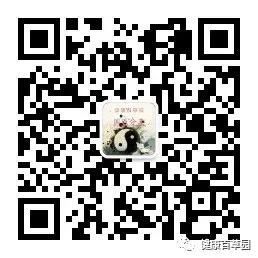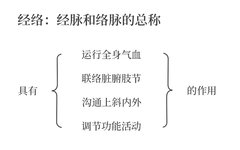The Concept of Meridians
Meridians are pathways that circulate Qi and blood throughout the body, connecting all parts and linking the organs and limbs, facilitating communication between the internal and external, as well as the upper and lower parts of the body.
This definition of meridians encompasses two aspects: one is the pathway for the circulation of Qi and blood, and the other is the pathway that connects the entire body.
There is another way to define meridians: the term meridians refers to the collective name for Jingmai (经脉) and Luomai (络脉).
Referring to meridians as the collective name for Jingmai and Luomai may help us systematically learn the course of meridians. Describing meridians as pathways that circulate Qi and blood and connect the entire body is a modern interpretation. As research on meridians deepens, new understandings and perspectives on their essence may emerge. With the advancement of medicine, our understanding will also deepen.
Based on our current understanding of meridians, we can merge the two definitions above to provide a more comprehensive view of what meridians are:
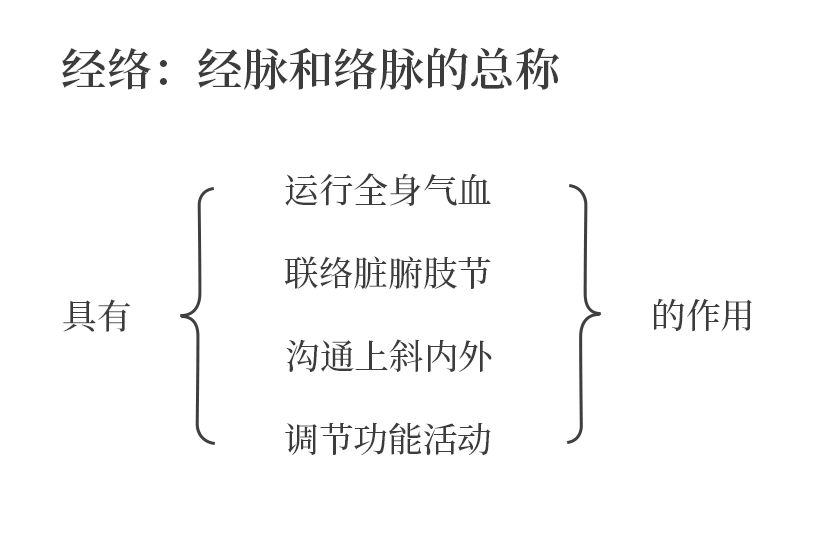
Jingmai and Luomai
Jingmai and Luomai are collectively referred to as “meridians.”
In the Shuowen Jiezi, “Jing” means “pathway,” which can be understood as a route or channel. Jingmai runs vertically through the body, connecting the organs internally and externally, serving as the main trunk of the meridian system. In the Shuowen Jiezi, “Luo” means “to connect,” which can be understood as a network. Luomai runs horizontally between Jingmai, interspersed throughout the body, serving as the branches of the meridian system.
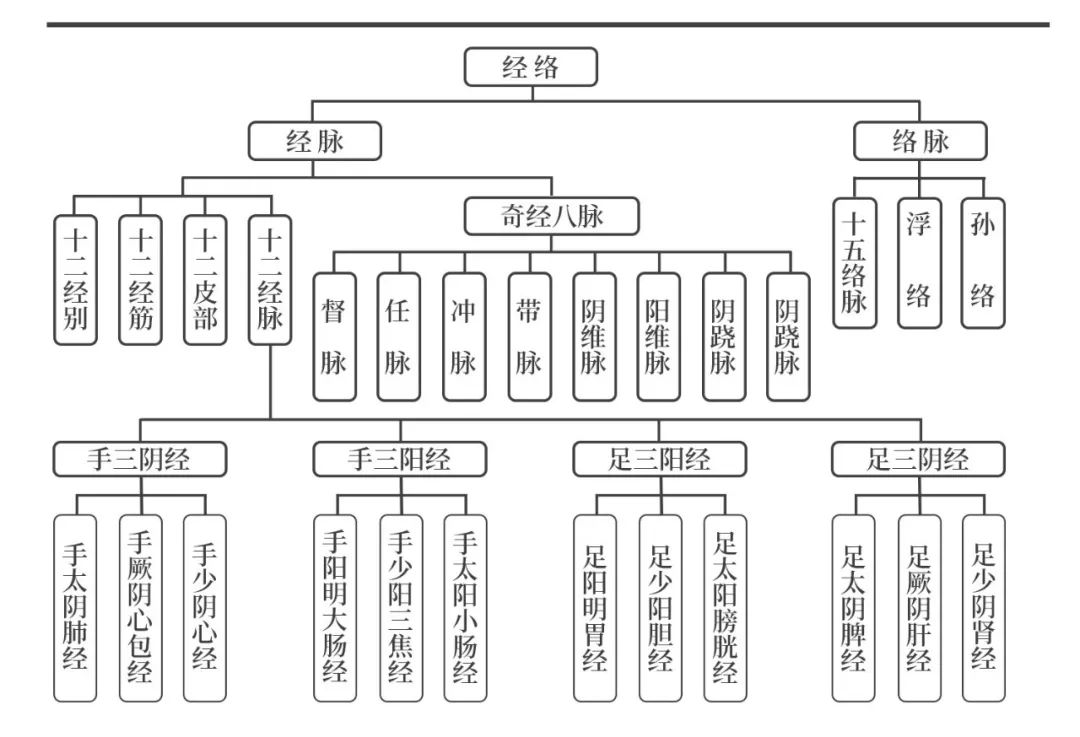
There are a total of fifty-six Jingmai, including twelve primary Jingmai, each with two symmetrical pathways, resulting in twenty-four; the twelve Jingbie (经别) are also symmetrical, totaling twenty-four, which adds up to forty-eight; the eight extraordinary meridians (奇经八脉) consist of eight pathways, bringing the total to fifty-six Jingmai.
Among these fifty-six Jingmai, only the Dai Mai (带脉) originates at the lateral costal region (located at the cartilage of the eleventh and twelfth ribs on both sides of the chest), encircling the waist like a belt, and it is the only horizontal meridian; the remaining fifty-five Jingmai are all vertical.
Luomai are branches of Jingmai, consisting of both vertical and horizontal pathways, interwoven like a network throughout the body, commonly referred to as “network distribution.”
Jingmai and Luomai together connect the organs, tissues, and structures of the body, including the skin, muscles, and bones, into an organic and unified whole. How is this organic whole constructed? How do complex tissues form a coordinated and unified system? We believe this is primarily reliant on the connecting function of the meridians.
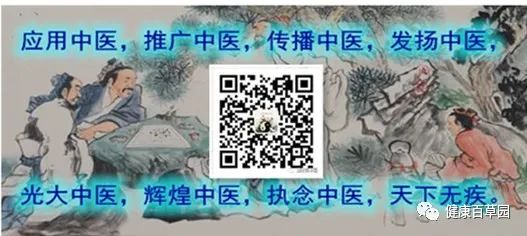
The Ling Shu: Ben Zang Pian states: “Meridians are the pathways for the circulation of Qi and blood, nourishing Yin and Yang, moistening the muscles and bones, and facilitating the joints.” This summarizes the functional role of meridians.
Meridians are the channels that connect the internal and external, link the upper and lower parts, circulate Qi and blood, distribute nutrients, collaborate to complete organ functions, and maintain the life activities of the body.
For the organism, meridians serve as the communication system for various body parts, the circulatory system for Qi and blood, the movement system that supports bones and facilitates joints, the response system for disease transmission, the defense system against external pathogens, and the adjustment system for regulating Yin and Yang balance.
Jingmai and Luomai are integrated and distributed throughout the body, with a close connection between the two that cannot be separated; yet they also have distinct characteristics.
1 Jing Deep, Luo Shallow
The Ling Shu: Jing Mai states: “How can we know the difference between Jingmai and Luomai?” Huang Di replied: “Jingmai are generally not visible… the visible pathways are all Luomai,” “The twelve Jingmai run deep between the muscles, hidden and unseen… all the floating pathways that are commonly seen are Luomai.”
The muscles between the flesh are referred to by ancient scholars as the outer layer of white flesh and the inner layer of red flesh, with clear boundaries between the red and white, hence the name “fenrou” (分肉).
Due to the deep and hidden nature of Jingmai within the body, and the superficial visibility of Luomai on the surface, in pathological conditions, Jingmai diseases are generally difficult to detect from the surface; they can only be understood through pulse diagnosis to assess the condition of Jingmai. In contrast, diseases of Luomai can often be observed in the distribution areas of Luomai on the surface, showing various pathological changes. The distinction of Jing being deep and Luo being shallow is relative.
Luomai themselves can also vary in depth, with Yang Luomai being shallower and Yin Luomai being deeper. The superficial Luomai can also penetrate deeper into the body, networking with the organs. However, for each organ and tissue, the distribution pattern remains that Jingmai are deeper and Luomai are superficial.
In meridian studies, there is also a concept of “Pibu” (皮部), which refers to the division of the skin on the surface according to the pathways of the meridians. When studying meridians, we sometimes hear the term “twelve Pibu,” which refers to the areas of the skin corresponding to the twelve Jingmai and their associated Luomai, where the Qi of the twelve Jingmai is distributed. The concept of “Pibu” does not consider the depth of Jingmai and Luomai, but rather projects everything onto the skin, delineating the corresponding areas.
The following image shows the fourteen Jingmai (the twelve regular Jingmai and the Ren and Du meridians from the eight extraordinary meridians) on the front skin map, displaying ten Pibu, with the Du meridian, the Foot Taiyang Bladder meridian, the Hand Taiyang Small Intestine meridian, and the Hand Shaoyang Sanjiao meridian corresponding to the Pibu on the back, which are not visible from the front.
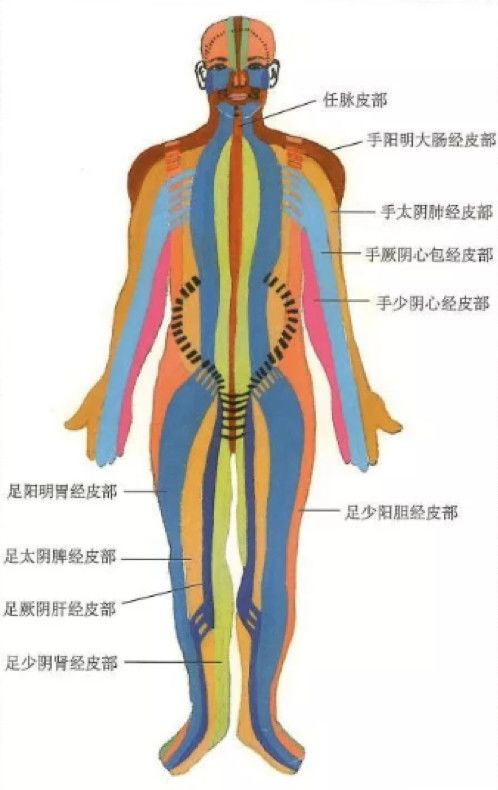
According to the theory of Pibu, there is a correspondence between different skin areas and different Jingmai, and different Jingmai also have a certain correspondence with different organs, which can assist us in treating diseases.
In terms of diagnosis, changes in skin color and morphology in different areas can indicate corresponding organ and meridian pathologies. For example, if there are nodules or muscle knots at the Gan Shu (肝俞穴) on the back corresponding to the Bladder meridian, it indicates that the liver Qi is not smooth, and the liver meridian is obstructed. If the skin at the Hand Jueyin Pericardium meridian is reddened or has rashes, it indicates heat in the Pericardium meridian, which has significant diagnostic value. This guidance for treatment will also be very precise.
In certain skin areas, we can also apply medicine; the widely circulated methods of “treating winter diseases in summer” through acupoint applications, navel therapy, warming moxibustion, and hot compresses are all techniques that use certain medicines or physical methods on the surface to achieve therapeutic effects or to regulate the physiological functions of the corresponding organs and meridians, thereby treating internal organ diseases.
2 Jing Straight, Luo Horizontal
Jingmai are the main trunk of the meridian system, running vertically through the body, with a longer pathway. Thus, the Yixue Rumen states: “Straight pathways are Jing.”
In their straight course, Jingmai can cross major joints and establish regular connections with corresponding organs, tissues, and structures. Luomai are the branches of the meridian system, running horizontally between Jingmai, with shorter pathways.
In their horizontal course, they generally do not cross larger joints, and their connections with organs, tissues, and structures are not as regular as those of Jingmai. Thus, the Ling Shu: Mai Du states: “Branches that run horizontally are Luomai.” The Ling Shu: Jing Mai states: “All Luomai cannot traverse major joints; they must exit through a separate pathway.”
3 Jing Thick, Luo Thin
Jingmai are like tree trunks, being the main body of the meridian system, relatively thick, referred to as “Da Jing” (大经) in the Huangdi Neijing; Luomai are like tree branches, being the branches of the meridian system, relatively thin, referred to as “Xiao Luo” (小络) in the Huangdi Neijing. Especially, Sun Luo (孙络) and Fu Luo (浮络) are even finer (the so-called “fifteen major Luo” refers only to their relative size compared to Sun Luo and Fu Luo).
Thus, the Lei Jing states: “Luo has sizes; the larger ones are called ‘Da Luo,’ and the smaller ones are called ‘Sun Luo’… The distinction of Luo is ‘Sun,’ which indicates its smallness. All fine pathways throughout the body are all Sun Luo.” “Jing is like the great rivers of the earth, while Luo is like the countless streams of the fields.” This provides a vivid description of the differences in thickness between Jingmai and Luomai.
4 Jing Few, Luo Many
Jingmai include the twelve primary Jingmai, the eight extraordinary meridians, and the twelve Jingbie, all of which have a fixed number. The associated structures of Jingmai, such as the twelve Jingjin (经筋) and twelve Pibu, are also categorized by the number “twelve.”
Luomai include sixteen major Luo, Sun Luo, and Fu Luo. Except for the sixteen major Luo, which have a fixed number, Sun Luo and Fu Luo are countless and innumerable.
The Zhenjing Zhinan states: “Luo has one hundred and fifty, with over three hundred horizontal Luo, and eighteen thousand fine Luo, with Sun Luo being innumerable.”

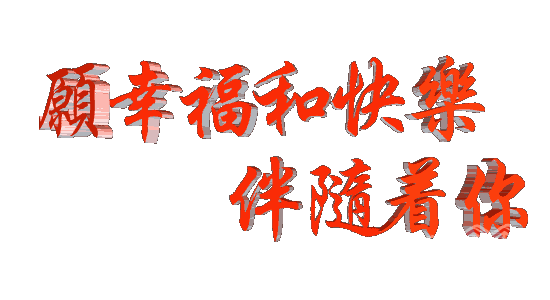

【Health Herbal Garden】Dedicated to sharing knowledge of Traditional Chinese Medicine, aiming to empower everyone with the wisdom to prevent and reduce illness; promoting TCM culture to minimize and avoid health tragedies. Please long-press the QR code below to follow and read a warm medical science article.

